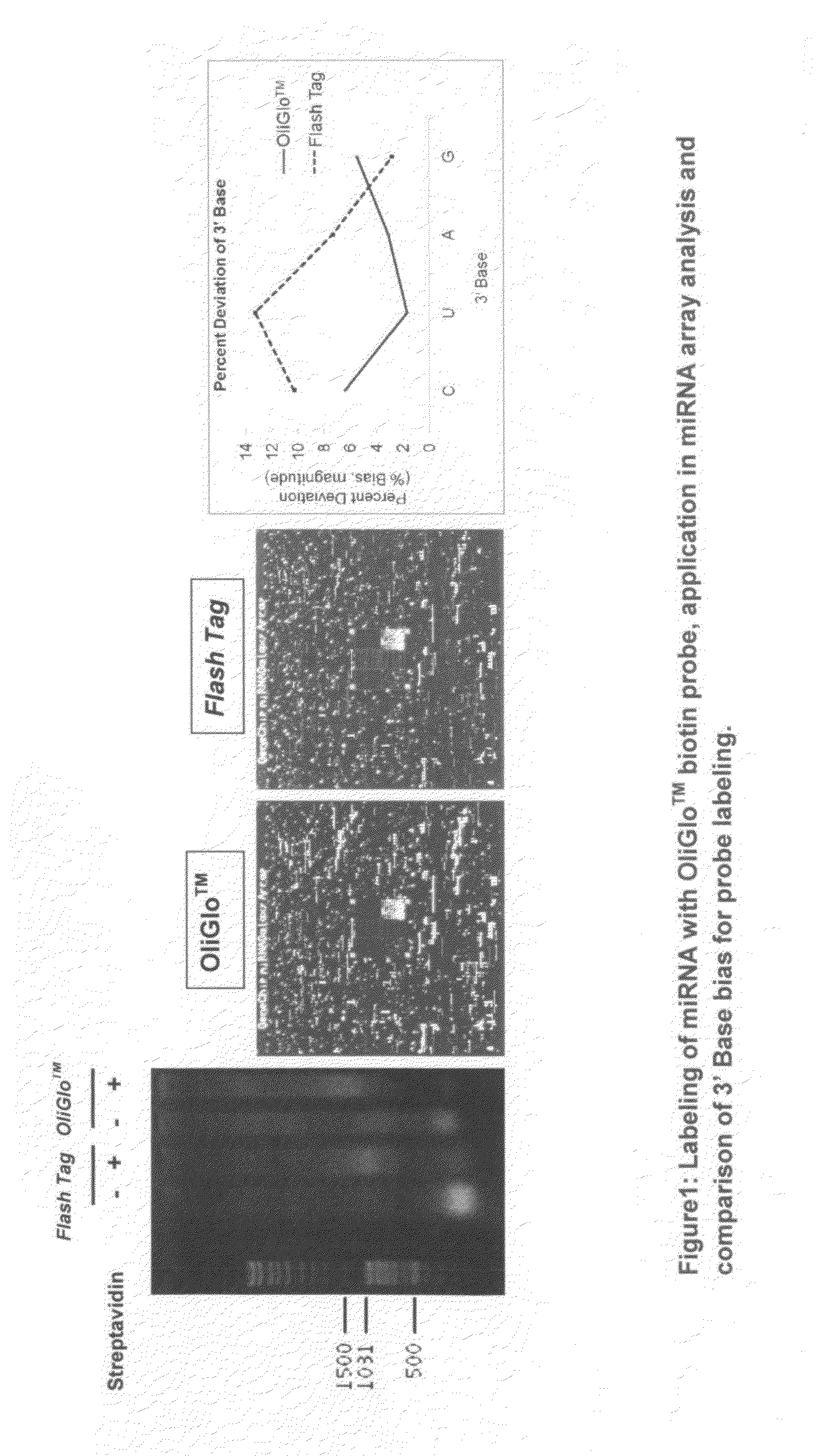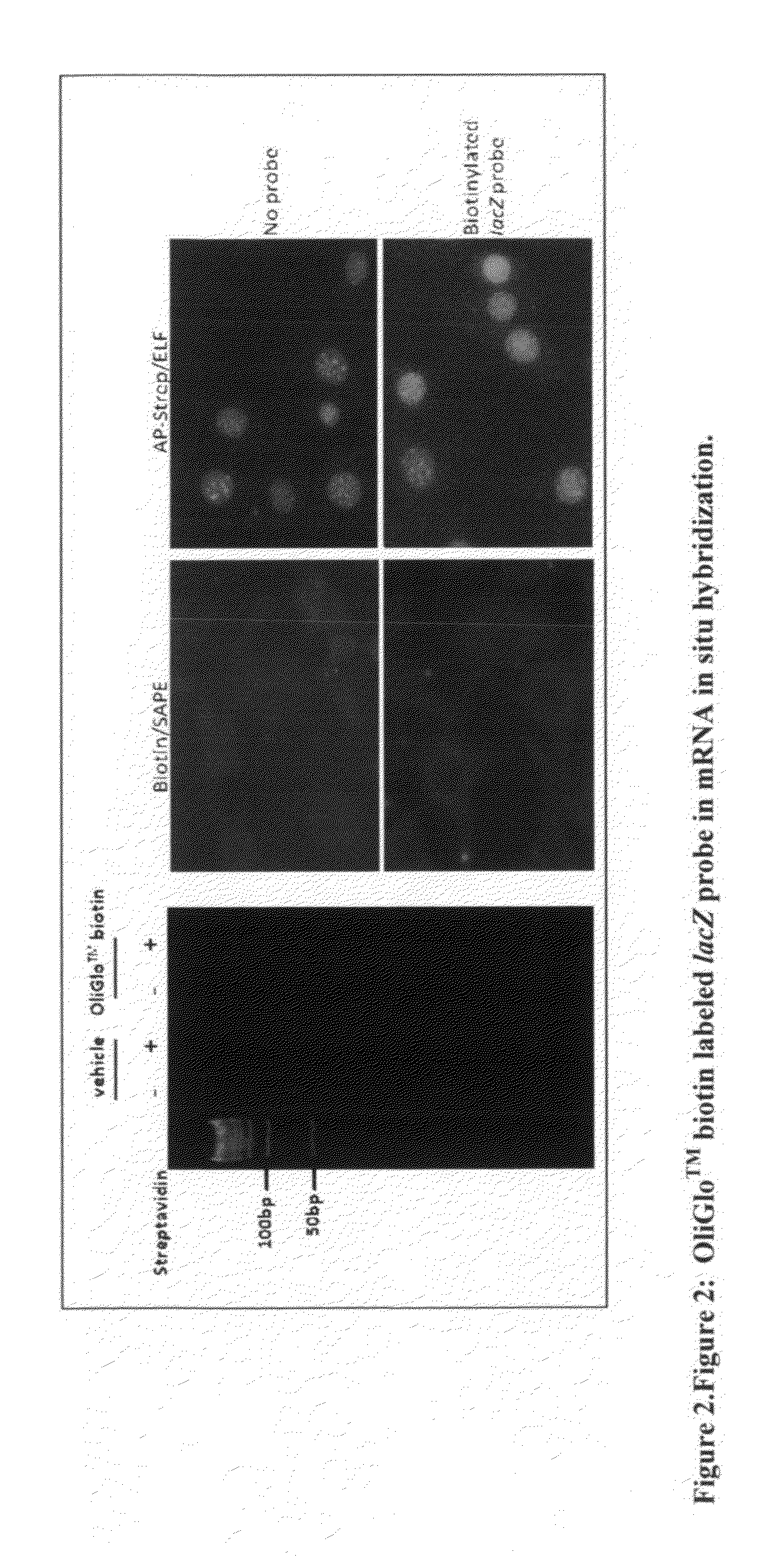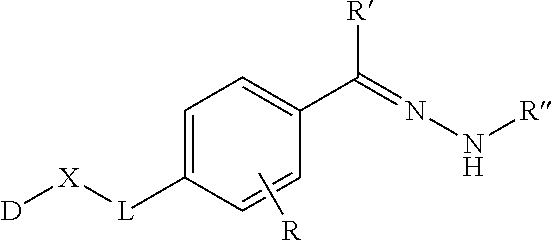Reagents and methods for direct labeling of nucleotides
- Summary
- Abstract
- Description
- Claims
- Application Information
AI Technical Summary
Benefits of technology
Problems solved by technology
Method used
Image
Examples
example 1
Preparation of 4-(2-aminoethyl)benzaldehyde hydrochloride (M0748)
[0111]The common precursor for the preparation of stable hydrazide dyes is 4-(2-aminoethyl)benzaldehyde hydrochloride. This aldehyde is prepared through conversion of 4-(2-aminoethyl)benzyl alcohol to the corresponding trifluoroacetamide (ethyl trifluoroacetate, diisopropylethyl amine, THF) followed by Swern oxidation and deprotection (HCl, water / methanol, reflux). Briefly, methyl-(4-alpha-bromomethyl)benzoate (15.85 g, 69.2 mmole) was dissolved in warm methanol (50 mL), cooled to room temperature and a solution of potassium cyanide (7.18 g, 120 mmole) in water (13 mL) added slowly with stirring, in the absence of heating. The exothermic reaction was cooled to room temperature, and allowed to react for 14 hours. The methanol was removed by vacuum distillation (rotovap) and the remaining aqueous solution extracted with diethylether (2×25 mL). The combined ether layers were washed with water (3×50 mL) and brine (1×50 mL)...
example 2
Preparation of a Stable Tetramethylrhodamine Based Labeling Reagent (Red Fluorescence) (M0774)
[0116]The stable labeling reagent N-(2-(1-(triisopropylsulfonylhydrazino)methylbenzene-4-yl)ethyl)-tetramethylrhodamine-5(&6)-carboxamide methyl ester (M0774) was prepared starting from commercially available 5(6)carboxy-tetramethylrhodamine (CTMR). CTMR (50 mg, 120 μmol) was dissolved in dry DMF (1 mL) and treated with disuccinimidyl carbonate (66 mg, 260 μmole) and DMAP (10 mg), allowed to react for 18 hours at room temperature under anhydrous conditions until TLC analysis showed complete conversion to the succinimidyl ester. The reaction was quenched with water (50 μL, 30 min) and purified by preparative TLC (8:2 CH2Cl2:MeOH). Treatment of the reactive ester with 4-(2-aminoethyl)benzaldehyde hydrochloride (M0748: 28 mg, 150 umole, prepared as described in Example 1) and diisopropylethylamine (28 μL, 160 μmol) gave the stabilized N-(2-(1-Benzaldehyde-4-yl)ethyl)-tetramethylrhodamine-5(&6)...
example 3
Preparation of Rhodamine 110 Based Labeling Reagents. (Green Fluorescence) (M0847)
[0122]5(6)-Carboxyrhodamine 110 (2.05 grams, 4.99 mmol, mixed-isomers) and diisopropylethylamine (3.51 mL, 20.2 mmol) were dissolved in dry DMF (10 mL), cooled to −10° C. (methanol, ice bath) and trityl chloride (2.81 grams, 10.1 mmol) added slowly with stirring. The reaction mixture was allowed to warm to room temperature, and continued stirring overnight at ambient temperature under dry N2(g). The reaction mixture was then poured into ice-water (110 mL), and the pH of the solution adjusted to pH 3 using dilute aqueous HCl solution. This mixture was extracted with ethyl acetate until no more red product was found in the aqueous layer, by TLC analysis (3:3:0.3:0.1 MeOH:CH2Cl2:water:NR4OH). The combined EtOAc layers were washed with water and brine (1×100 mL each), filtered and the organic layer evaporated to a red solid which was purified by silicagel 60 column chromatography (1×40 cm) using 20% methan...
PUM
| Property | Measurement | Unit |
|---|---|---|
| Fraction | aaaaa | aaaaa |
| Length | aaaaa | aaaaa |
| Length | aaaaa | aaaaa |
Abstract
Description
Claims
Application Information
 Login to View More
Login to View More - R&D
- Intellectual Property
- Life Sciences
- Materials
- Tech Scout
- Unparalleled Data Quality
- Higher Quality Content
- 60% Fewer Hallucinations
Browse by: Latest US Patents, China's latest patents, Technical Efficacy Thesaurus, Application Domain, Technology Topic, Popular Technical Reports.
© 2025 PatSnap. All rights reserved.Legal|Privacy policy|Modern Slavery Act Transparency Statement|Sitemap|About US| Contact US: help@patsnap.com



